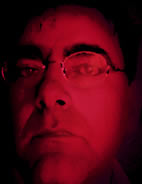|
Michele D’Alterio’s art has always been full of symbolic references, of atmospheres being between reality and dream, conveyed not only from an expressive point of view, for what imagine evokes emotionally and psychologically, but also from a formal and conceptual point of view. Indeed the artist’s correctness of speech, since his first tries of surreal tone-spaces of a universe of imaginary shapes where the oneiric symbol is full of psychological and poetical clues- seems to reside just in his way of working matter with a realistic, allusive outlook, but under the boost of an intrinsic, visionary capacity, related to the same suggestive revealing of matter, being a tridimentional scenario of evocations reflected into unconscious. His “landscapes” aren’t simply surreal, they don’t allude only to a disturbed and fantastic reality, all internal, confined out of the time, but they have the tone, I mean the mistery and the magic of a hidden and solemn dimension of being and feeling, that unfoldes without noise, in an absolute silence. Clear shapes even in their corporal relief open up to tridimentional, internal, mysterious, often unsettling, always deep spaces. Also the strictly technologic aspect of D’Alterio’s art is interesting: the use of materials, their superimposition, their experimentation. Only outwardly his latest works, the present exhibition ones, have a more conceptual note, based on bivalence, on a symbolic and emotional dualism, of opposing reality: white and black, good and evil, big and small. Space takes external signs only on the surface, identifiable by direct allusions for example to a cross or a cellular tissue. In actual fact he always deals with internal realms of life, with inner glances, with spaces weaved into the silence of a well-educated universe which is reflected inside a sensitive consciousness. The appeal of his works comes from here, they also retain the tactile intensity and the splendour of his more materialistic production. His art is like intrapsychic journey, like going across the soul. That’s where the present and the absentee, the contingent and the absolute combine without effort.
Giorgio Agnisola
EXHIBITION HISTORY
Michele D’Alterio was born in Caserta in 1968. He obtained a diploma at the Academy of Art in Naples in 1990 under the guidance of the Master Armando De Stefano. He teaches in public secondary schools (Senior high school specializing in an artistic education, Art Institute,etc.) and with private corporations in Caserta relating to subjects as Painting and Computer graphics. He applies himself , besides painting, to graphics, illustration, web design, photography, video and use of various forms of media. In 1998 he created the Studio Dharma where he works as creative graphic designer. In 1996 he took part, as illustrator, in the selection of the Book Exhibit for young people in Bologna. Since 2003 his painting production has become more remarkable, through a research route that, starting from surrealism and expressionism, strives for probing into artistic territories and unexplored languages, using also a rich experimentation on materials. In 2004 he exhibited his works in the following exhibitions: -Gaeta: “Porticato gaetano”; -Caiazzo, Casa della Cultura: “Frammenti di senso”; In 2005: Santa Maria Capua Vetere: “B-Fronte”, IL Pilastro Gallery. Rome, Trastevere: “Ab Ovo” by Aistetikà. In 2006: Capua, Guida bookshop; solo show. Belvedere di S. Leucio (Caserta), performance of Art Institute teachers. In 2007: -Naples, “Il Ramo d’Oro” Centre, “The Border”, with Zoran Poposki. He lives and works in Caserta.
MICHELE D’ALTERIO’S SURREAL SENSITIVITY
Michele D’Alterio, an expert on graphic design and web design, has never given up painting, seen as withdrawal and projection of his own privacy. In his later works, hovering between figuration and abstraction, the natural landscape personifies the spirit outline. With his surreal sensitivity, Michele D’Alterio strives for combining two opposite aptitudes: on the one hand his need to attack the canvas with vigorous outburst in order to humour his internal impulses, on the other hand his will to dull his urges in the harmony of a natural landscape. There are everyday objects in his works, as plastic bags and chips of rubber, taken out of their own context in order to assume dimension of signs. The reflections of urban life combine with dreamy visions, timeless landscapes where the depth isn’t given by the traditional perspective, but by the progressive dilution of the pictorial matter. The vertical format, drawing its inspiration from the far East painting, suggests an ascensional tension. The size of the frame, intentionally bigger than the picture, expresses the will not to repress the tension of the scene, that ideally develops beyond the painting edges.
Marco di Mauro
 |
